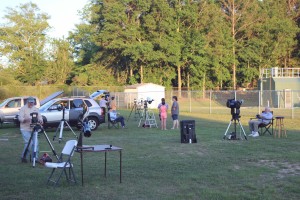After several straight weeks of rain and cloudy weather, Friday the 1st was absolutely clear. The only thing that kept it from being perfect was a Moon two days from full. But that did not dampen Baker School Family STEM night as we had lots of scopes, lots of celestial targets and lots of guest observers.
Dennis Hausch, Frank Atchison and Tom Haugh arrived early and setup well before sunset allowing several of the staff and assistants to safely view the Sun. They were able to view the solar disk in white and hydrogen-alpha light. Although there was very little in the way of sun spots, there was a very nice full loop prominence visible.
As the Sun set, the solar scopes and filters were swapped out for dark sky equipment. By this time Ken Leone and Ken Sharpe had joined the group and set up their scopes as well.
By now, a steady flow of guest observers were making their way out to the observing field. Since Venus was high in the sky and easily visible in the deepening light, it was the first nighttime object viewed. Jupiter and the rising Moon followed in quick succession. Although Mars was too low on the horizon, Mercury was still visible above the school buildings to the West.
Club members fielded questions from the very enthusiastic guest observers as they made their way to each telescope. Once the skies were fully dark, many deep sky objects were presented such as the Beehive Cluster and the Whirlpool Galaxy.
We would like to thank the staff and students of Baker School for the invitation to participate in their STEM night again this year. We especially want to thank them for the new route to the observing field allowing us to drive on to the field instead of hauling all our equipment by hand. Thanks also go to Ken Sharpe for the photography.
